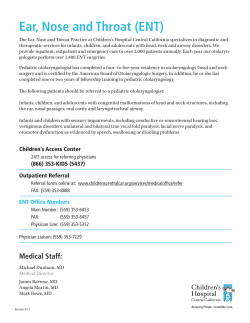
Name /bks_53161_deglins_md_disk/fluticasonenasal 02/12/2014... pg 1 # 1
Name /bks_53161_deglins_md_disk/fluticasonenasal 02/12/2014 03:24PM Plate # 0-Composite pg 1 # 1 Adverse Reactions/Side Effects CNS: headache. EENT: epistaxis, nasal burning, nasal irritation, nasopharyngeal fungal infection, pharyngitis. GI: nausea, vomiting. Endo: adrenal suppression (q dose, long-term therapy only),pgrowth (children). Derm: rash, urticaria. Resp: cough. Misc: ANAPHYLAXIS, ANGIOEDEMA. 1 fluticasone (nasal) (floo-ti-ka-sone) Avamys, Flonase, Veramyst Classification Therapeutic: anti-inflammatories (steroidal) Pharmacologic: corticosteroids Pregnancy Category C Interactions Drug-Drug: Ritonavir and ketoconazolepmetabolism andqlevels of fluticasone. Concomitant use of ritonavir and fluticasone not recommended. Route/Dosage Indications Seasonal or perennial allergic rhinitis. Seasonal or perennial nonallergic rhinitis (Flonase only). Action Potent, locally acting anti-inflammatory and immune modifier. Therapeutic Effects: Decrease in symptoms of allergic and nonallergic rhinitis. Pharmacokinetics Absorption: ⬍2%; action is primarily local following nasal use. Distribution: Crosses the placenta and enters breast milk in small amounts. Metabolism and Excretion: Rapidly and extensively metabolized by the liver; primarily excreted in feces; ⬍5% excreted in urine. Half-life: 7.8 hr. TIME/ACTION PROFILE (improvement in symptoms) ROUTE ONSET PEAK DURATION Intranasal few days up to 3 wk unknown Contraindications/Precautions Contraindicated in: Hypersensitivity (Flonase contains alcohol). Use Cautiously in: Active untreated infections; Diabetes or glaucoma; Underlying immunosuppression (due to disease or concurrent therapy); Systemic corticosteroid therapy (should not be abruptly discontinued when intranasal therapy is started); Concurrent use of ritonavir; Recent nasal trauma, septal ulcers, or surgery (wound healing may be impaired by nasal corticosteroids); OB, Lactation, Pedi: Pregnancy, lactation, or children ⬍4 yr (for Flonase) or ⬍2 yr (for Veramyst) (safety not established; prolonged or high-dose therapy may lead to complications). ⫽ Canadian drug name. ⫽ Genetic Implication. Intranasal (Adults): Flonase– 2 sprays in each nostril once daily or 1 spray in each nostril twice daily (not to exceed 2 sprays in each nostril/day); after several days, attempt topdose to 1 spray in each nostril once daily. Patients ⱖ 12 yr with seasonal allergic rhinitis may also use 2 sprays in each nostril once daily on an as-needed basis; Veramyst– 2 sprays in each nostril once daily or 1 spray in each nostril twice daily; once symptoms controlled, attempt topdose to 1 spray in each nostril once daily. Intranasal (Children ⱖ4 yr): Flonase– 1 spray in each nostril once daily (not to exceed 2 sprays in each nostril/day). Intranasal (Children 2– 11 yrs): Veramyst– 1 spray in each nostril daily; mayq to 2 sprays if no response; once symptoms controlled, attempt topdose to 1 spray/ day. NURSING IMPLICATIONS Assessment ● Monitor degree of nasal stuffiness, amount and color of nasal discharge, and fre- quency of sneezing. ● Patients on long-term therapy should have periodic otolaryngologic examinations to monitor nasal mucosa and passages for infection or ulceration. ● Monitor growth rate in children receiving chronic therapy; use lowest possible dose. ● Monitor for signs and symptoms of hypersensitivity reactions (rash, pruritis, swelling of face and neck, dyspnea) periodically during therapy. ● Lab Test Considerations: Periodic adrenal function tests may be ordered to assess degree of hypothalamic-pituitary-adrenal (HPA) axis suppression in CAPITALS indicate life-threatening, underlines indicate most frequent. Strikethrough ⫽ Discontinued. PDF Page #1 Name /bks_53161_deglins_md_disk/fluticasonenasal 02/12/2014 03:24PM Plate # 0-Composite Evaluation/Desired Outcomes 2 chronic therapy. Children and patients using higher than recommended doses are at highest risk for HPA suppression. Potential Nursing Diagnoses ● Resolution of nasal stuffiness, discharge, and sneezing in seasonal or perennial rhinitis. Why was this drug prescribed for your patient? Ineffective airway clearance (Indications) Risk for infection (Side Effects) Deficient knowledge, related to medication regimen (Patient/Family Teaching) Implementation ● Do not confuse Flovent (fluticasone oral inhalation) with Flonase (fluti- casone nasal spray). ● After the desired clinical effect has been obtained, attempts should be made to de- crease dose to lowest amount. Gradually decrease dose every 2– 4 wk as long as desired effect is maintained. If symptoms return, dose may briefly return to starting dose. ● Intranasal: Patients also using a nasal decongestant should be given decongestant 5– 15 min before corticosteroid nasal spray. If patient is unable to breathe freely through nasal passages, instruct patient to blow nose gently in advance of medication administration. Patient/Family Teaching ● Advise patient to take medication exactly as directed. Take missed doses as soon as remembered unless almost time for next dose. ● Instruct patient in correct technique for administering nasal spray. Shake well be- ● ● ● ● pg 2 # 2 fore use. Before first-time use, prime unit by spraying 6 times. If not used for at least 7 days or if cap left off for more than 5 days, reprime unit. Warn patient that temporary nasal stinging may occur. Instruct patient to stop fluticasone and notify health care professional immediately if signs of anaphylaxis (rash, hives, difficulty breathing, swollen lips or throat) occur. Instruct patient to notify health care professional of all Rx or OTC medications, vitamins, or herbal products being taken and consult health care professional before taking other Rx, OTC, or herbal products. Advise female patients to notify health care professional if pregnancy is planned or suspected or if breast feeding. Instruct patient to notify health care professional if symptoms do not improve within 1 mo or if symptoms worsen. 䉷 2015 F.A. Davis Company PDF Page #2
© Copyright 2025





















